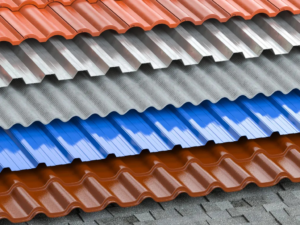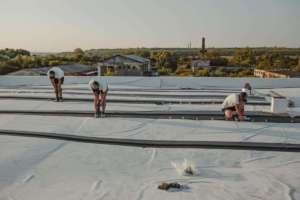Roofing Basics
A building’s roof is a critical element that protects it from natural elements and influences its overall aesthetic appeal. Whether you are a homeowner or a budding architect, understanding roofing basics is essential to making informed decisions.
Wood shingles and shakes provide natural insulation, keeping homes cooler in summer and warmer in winter. They also offer durability. But wood must be treated with preservatives and repellents to protect against mold and mildew. Contact High Point Roofing now!

Roofing is designed to protect the interior of homes and businesses from extreme weather conditions like rain, heat and cold. In addition, roofing helps to protect from wind, heavy snow and hail. However, some roofing materials are better suited to certain types of weather conditions than others.
During a storm, debris such as broken tree branches, dirt and mud, and acorns can become lodged against the roof and cause damage. A roof should be regularly inspected to make sure that there are no weak spots or holes that could allow rain to leak into the house.
To help prevent further damage, a temporary roofing solution like Stormseal can be used to shield the building until permanent repairs can be made. This polyethylene film is heat-shrinkable and securely wraps the entire damaged area, protecting it from further wind, rain and hail until the repair work is complete. Unlike tarps, this innovative product is installed once and stays on for as long as it takes to get the building back in service.
Another form of weather protection is to fit an extra layer of water-resistant material under the shingles on the top part of the roof. This is known as weather guard or ice shielding and is an essential part of any Inclement Weather Plan. This will safeguard against water infiltration into the home’s plywood, insulation and drywall when ice dams or gutters become blocked. Also, it prolongs the lifespan of the shingles on the roof by keeping them dry. This can be done easily with a little forethought and planning.
Curb Appeal
Few elements of a home or building have as much impact on the overall aesthetics and curb appeal as the roof. A well-chosen and beautifully maintained roof can elevate a property’s look, and it can even enhance its value.
The term “curb appeal” is often used to describe the attractiveness of a property from the street or sidewalk, and it encompasses everything from landscaping and exterior paint to windows, doors, and even a house’s number plate or mailbox. Curb appeal can make or break a first impression on visitors, and it is an important element to consider when designing a new home or renovating an existing one.
Many homeowners focus on enhancing their property’s curb appeal, and many of these tasks are relatively inexpensive. The most common ways to improve a home’s curb appeal include a fresh coat of paint, cleaning up the landscape outside, or replacing items like an outdated light fixture or mailbox. While it may seem obvious that a well-maintained lawn, fresh paint, and attractive landscaping are critical to curb appeal, it is also important to remember that the roof plays a major role in protecting a property and defining its visual appeal.
Choosing the right roofing material and color is essential for enhancing a home’s curb appeal, and it can be a great way to reflect a homeowner’s unique taste and style. For example, light colors can help to reduce energy costs by reflecting sunlight and keeping a home cooler during the summer, while darker colors can provide a more traditional or contemporary look.
Professional roofing contractors can help a homeowner select the ideal roof for enhancing curb appeal, and they can also guide them through other choices that can benefit a home in terms of protection and value. For instance, the team at Southern National can help a homeowner choose between asphalt shingles, metal roofing, or clay tile, discussing the pros and cons of each option to ensure that the final decision is an excellent fit for the property.
In addition to enhancing a home’s appearance, a new roof can play a significant role in increasing its value, and it is an investment that will pay off down the road. For a home that looks beautiful from the curb and has an appealing and protective roof, the next step is to ensure that the rest of the structure is in good condition.
Maintenance
A roof requires regular maintenance to keep it functioning at its best. Debris such as dirt, twigs, and leaves should be removed regularly to prevent water retention that can cause damage. Field drains and auxiliary drains should also be kept clear to prevent ponding that can lead to leaks and structural damage. Caulking should be checked on a regular basis and replaced when needed to protect against leaks. Regular trimming of tree limbs that hang near the home can also help to prevent damage during storms.
Clay shingles
Clay tile and slate shingles are a beautiful roofing option for homeowners who want to add a traditional style to their home. These shingles have a long lifespan and provide many benefits to homeowners. They are also highly fire-resistant and wick off rainwater more effectively than asphalt shingles. They are also less susceptible to algae growth and rot. These shingles also have a distinct look and can complement any architectural style. However, these shingles are expensive compared to other roofing materials and require a significant investment in labor and installation.
Clay shingles are made by baking molded clay until it is hardened. This process produces a variety of colors, including white, yellow or orange and brown. A common color for clay shingles is terracotta, which has the familiar burnt-orange tint that most people associate with traditional Spanish style homes. These shingles are incredibly durable and can last up to 100 years or more. They are also water resistant and withstand hurricane-strength winds. They can even be used in coastal areas where salty air can damage metal and asphalt shingles.
They are also an excellent energy-efficient choice, as they help regulate indoor temperatures and reduce the strain on HVAC systems. However, clay tiles are more susceptible to cracking and tearing when they are handled improperly. They must be carefully installed and maintained by professional roofers. These shingles are also very heavy and can overload a roof, which requires a more stable structural design.
Unlike other roofing materials, tile roofs are extremely durable and can last up to 50 years. They are a popular roofing option in Europe, where they are often seen on historical buildings and other structures. The durability of these shingles comes at a cost, though, as the initial expense can be prohibitive for some homeowners. The initial expense does not include any upgrades to the structure that may be needed to support the heaviness of these shingles.
Unlike shingle roofs, a tile or slate roof can be easily maintained and cleaned. Regular inspections of the roof should be conducted to identify potential problems and address them quickly. In addition, debris should be cleared from the roof to avoid clogging gutters. It is also a good idea to install wire mesh covers over the gutters to prevent excessive debris buildup.
